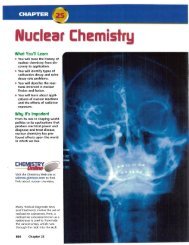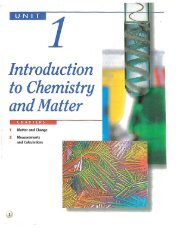Solutions
Solutions
Solutions
Create successful ePaper yourself
Turn your PDF publications into a flip-book with our unique Google optimized e-Paper software.
~ STANDARDIZED TEST PRACTICE<br />
~ CHAPTER 14<br />
Use these questions and the test-taking tip to prepare<br />
for your standardized test.<br />
1. The kinetic-molecular theory describes the microscopic<br />
behavior of gases. One main point of the theory<br />
is that within a sample of gas, the frequency of collisions<br />
between individual gas particles and between the<br />
particles and the walls of their container increases if<br />
the sample is compressed. The gas law that states this<br />
relationship in mathematical terms is __ .<br />
a. Gay-Lussac's Law<br />
b. Charles's Law<br />
c. Boyle's Law<br />
d. Avogadro's Law<br />
2. Three 2.0-L containers are placed in a 50°C room.<br />
Samples of 0.5 mol Nz, 0.5 mol Xe, and 0.5 mol<br />
ethene (C z H 4<br />
) are pumped into Containers 1,2, and 3,<br />
respectively. Inside which container will the pressure,<br />
be greatest<br />
a. Container 2<br />
b. Container 3<br />
c. Containers 2 and 3 have the same, higher pressure<br />
d. Containers 1,2, and 3 have equal pressures<br />
Interpreting Graphs Use the graph to answer<br />
questions 3-5.<br />
1200<br />
1000<br />
ca 800<br />
Q.<br />
::::.<br />
Ql<br />
...<br />
600<br />
:::l<br />
III<br />
Ql<br />
...<br />
400<br />
Q.<br />
200<br />
I""""<br />
Pressures of Three Gases<br />
at Different Temperatures<br />
~<br />
1/<br />
/:V<br />
~~<br />
~ j.,..ooo"""<br />
Gas C<br />
Gas A<br />
Gas B<br />
5. The predicted pressure of Gas B at 310 K is __ .<br />
a. 260 kPa c. 1000 kPa<br />
b. 620 kPa d. 1200 kPa<br />
6. What volume will 0.875 moles of SF 4<br />
occupy at STP<br />
a.19.6L c.22.4L<br />
b. 21.4 L d. 32.7 L<br />
7. While it is on the ground, a blimp is filled with<br />
5.66 X 10 6 L of He gas. The pressure inside the<br />
grounded blimp, where the temperature is 25°C, is<br />
1.10 atm. Modem blimps are non-rigid, which means<br />
that their volume is changeable. If the pressure inside<br />
the blimp remains the same, what will be the volume<br />
of the blimp at a height of 2300 m, where the temperature<br />
is 12°C<br />
a. 5.66 X 10 6 L<br />
b. 2.72 X 10 6 L<br />
c. 5.4 X 10 6 L<br />
d. 5.92 X 10 6 L<br />
8. The reaction that provides blowtorches with their<br />
intense flame is the combustion of acetylene (CzH z ) to<br />
form carbon dioxide and water vapor. Assuming that<br />
the pressure and temperature of the reactants are the<br />
same, what volume of oxygen gas is required to completely<br />
bum 5.60 L of acetylene<br />
a. 2.24 L c. 11.2 L<br />
b. 5.60 L d. 14.0 L<br />
9. A sample of argon gas is compressed into a volume of<br />
0.712 L by a piston exerting 3.92 atm of pressure. The<br />
piston is slowly released until the pressure of the gas<br />
is 1.50 atm. The new volume of the gas is __ .<br />
a. 0.272 L<br />
b. 3.67 L<br />
a. 0.0174 atm<br />
b. 0.296 atm<br />
c. 1.86 L<br />
d.4.19L<br />
10. Assuming ideal behavior, how much pressure will<br />
0.0468 g of ammonia (NH3) gas exert on the walls of<br />
a 4.00-L container at 35.0°C<br />
c. 0.00198 atm<br />
d. 0.278 atm<br />
o<br />
250<br />
260 270 280 290<br />
Temperature (K)<br />
300<br />
3. It can be seen from the graph that__ .<br />
a. as temperature increases, pressure decreases<br />
b. as pressure increases, volume decreases<br />
c. as temperature decreases, moles decrease<br />
d. as pressure decreases, temperature decreases<br />
4. Which of these gases is an ideal gas<br />
a. Gas A c. Gas C<br />
b. Gas B d. none of the above<br />
Ask Questions If you've got a question about<br />
what will be on the test, the way the test is scored,<br />
the time limits placed on each section, or anything<br />
else...by all means ask! Will you be required to<br />
know the specific names of the gas laws, such as<br />
Boyle's law and Charles's law<br />
Standardized Test Practice 451












